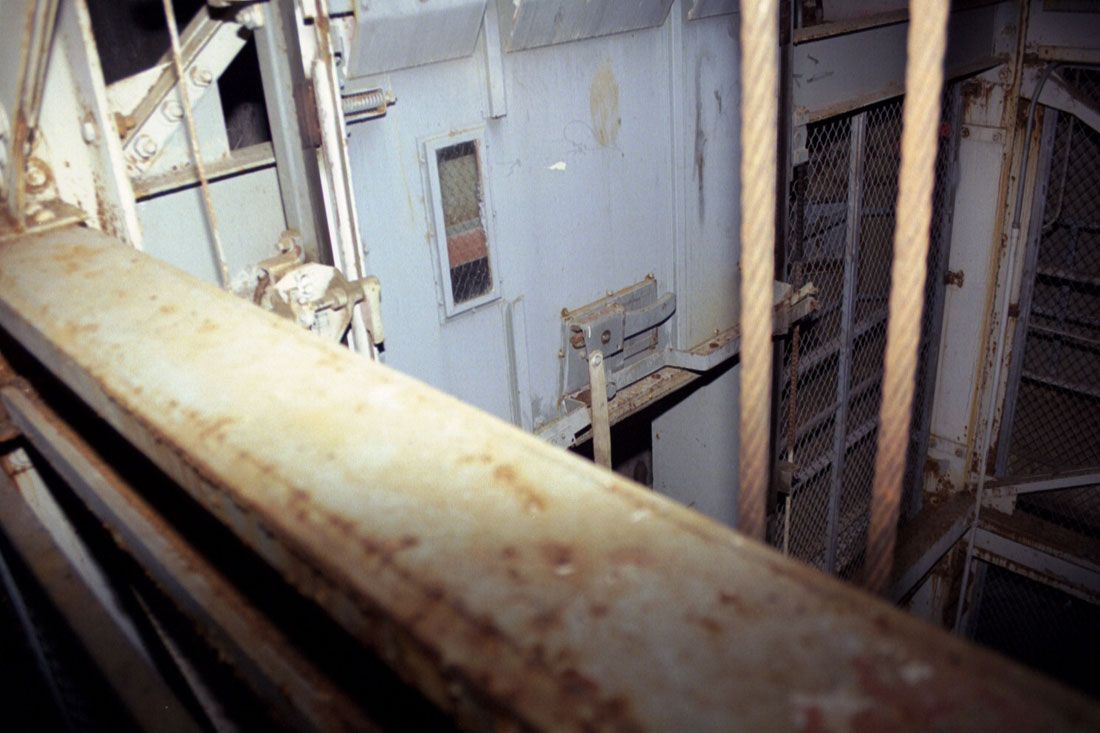This
is the entrance to the Titan I complex. A massive concrete and
steel slab opens hydraulically like a great yawning mouth. This is
the single point of entry and exit to the complex excepting an
emergency.
|
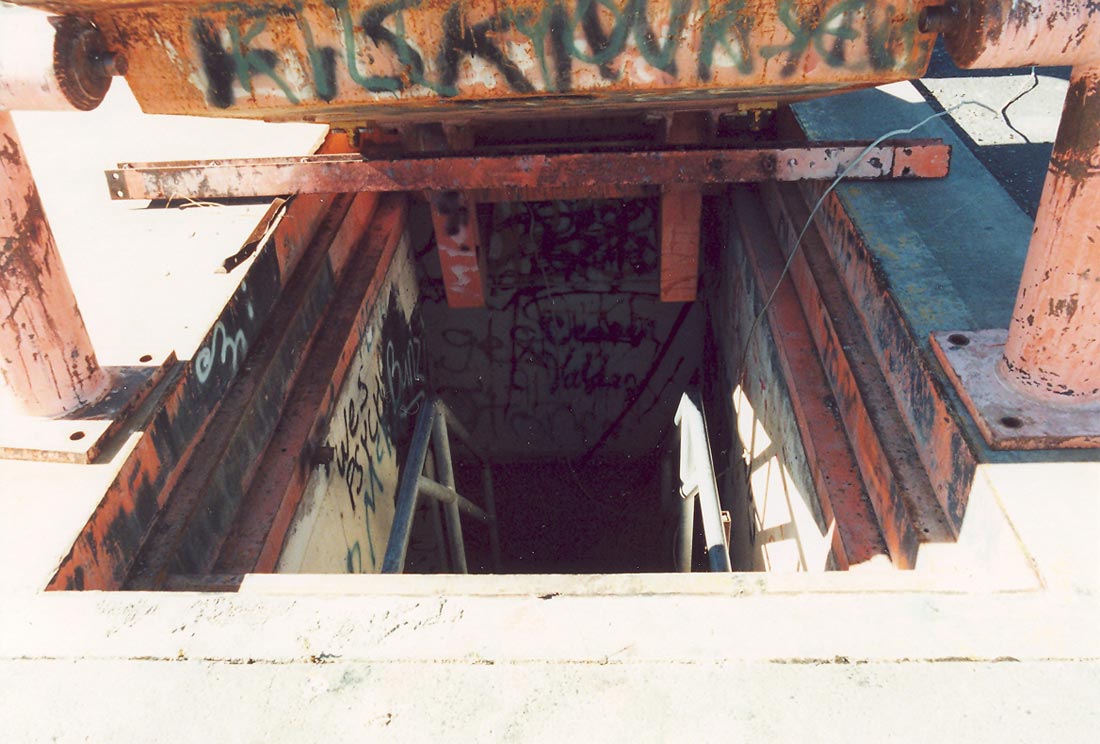
Larson
568-A: The cellar stairs entrance, much the worse for wear, propped open
and copiously vandalized with silly scribblings. Photo
courtesy of Walter Silva
|
A short
set of steel steps leads to a very heavy revolving metal door. The
door has an interlocking mechanism which only allows passage to one
person at a time. Inside the Control Center a monitor displays
anyone waiting at the door. Access is granted remotely from the
facilities console in the Control Center. Once the concrete slab/mouth closes, occupants are
trapped between it and the door until cleared to proceed. If
someone does not clear or any problem whatsoever occurs at this point,
they are held in this entrapment until security arrives.
|

Lowry
724-C, 1999: This
photo shows the rather sloppy marriage of the new stairwell to the
cylindrical portal where the spiral stairs once were. The concrete
has separated by several inches at the join between the 2
structures. A ladder is visible leading to the original portal
opening.
|
Immediately
on entering the site you notice a strong, permeating odor. It is
everywhere and is found in all of the sites. When you leave your
clothing reeks of it. You've encountered "Titan Halitosis".
It's
difficult to describe the smell to someone who hasn't experienced it
firsthand. It has been described as a combination of diesel fuel,
mold, various chemical cocktails, rust and stale musty air. Now
that you've entered the Titan, it envelops you.
As
the Titan's unique stench takes you, the temperature also begins to
drop. Just like any cave, as you descend, the ambient temperature
falls. Inside the Titan the temperature remains around 56 degrees Fahrenheit
year-round. The humidity climbs steadily as well, and depending on
the season the interior may be entirely coated with dew in some areas.
|
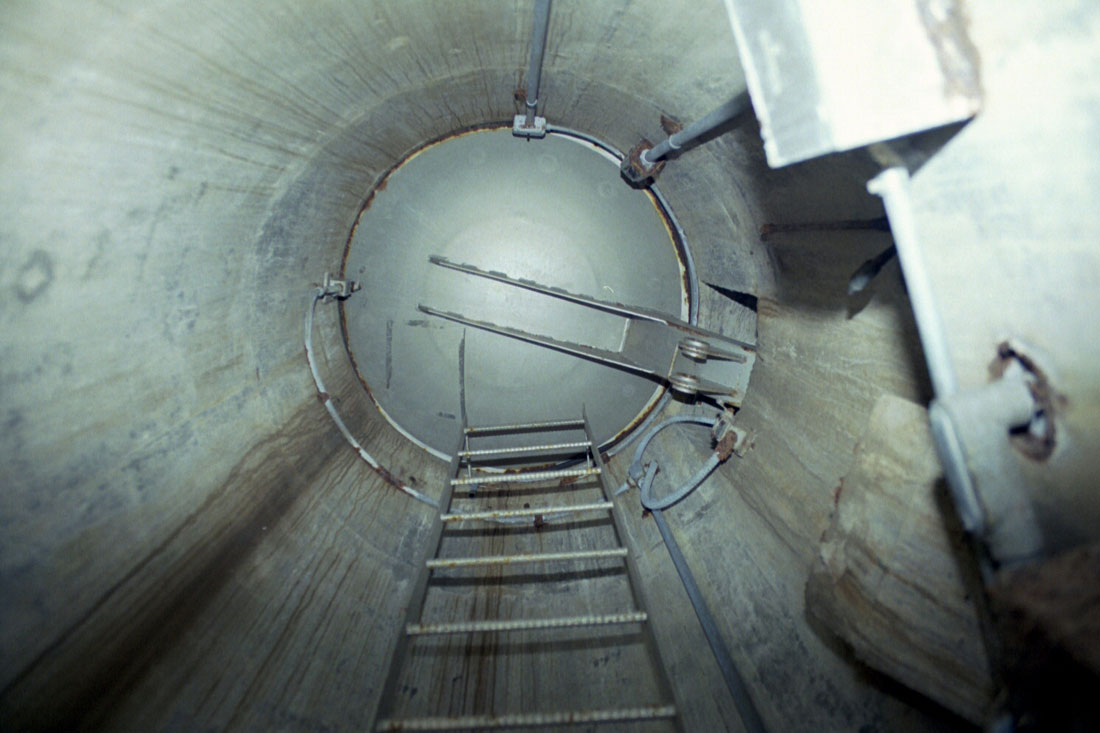
Lowry
724-C, 1999: Looking up at the original hatch cover. The spiral
staircase has been removed and a ladder installed for use as a secondary
entrance/exit.
|
Once
beyond the revolving door, a 6-story descent awaits down a metal
stairway which spirals around a central shaft containing a 4-ton freight
elevator. The freight elevator is for heavy equipment and goes all
the way to the surface if necessary.
At
the bottom of the portal stands 8'x8' blast doors of thick steel that
resemble a bank vault. The blast doors are always closed when the
elevator doors are open to prevent transmission of any shock through the
complex in a strike. This same sort of safeguard is used
throughout the complex. All the concrete and steel used to shield
the airmen and the weapons underground would be for of little use if
someone left the door open.
|

Lowry
724-C, 1999: The
round gray area once held the revolving door, long since removed by
salvage contractors to make their task easier. Note the caution
strip-- this is where the very unfortunate laborer was killed when he
fell into the revolving door while it was still moving.
The steelwork for the freight elevator shaft can be seen
through the opening.
|
This
narrow passage greets you at the portal silo. Beyond it there is a
defunct freight elevator and many, many steps leading down. Even
in good shape, I found going up and down these stairs twenty times in a
day to be quite a challenge. The elevator is not an option here so
you'll have to walk down.
|
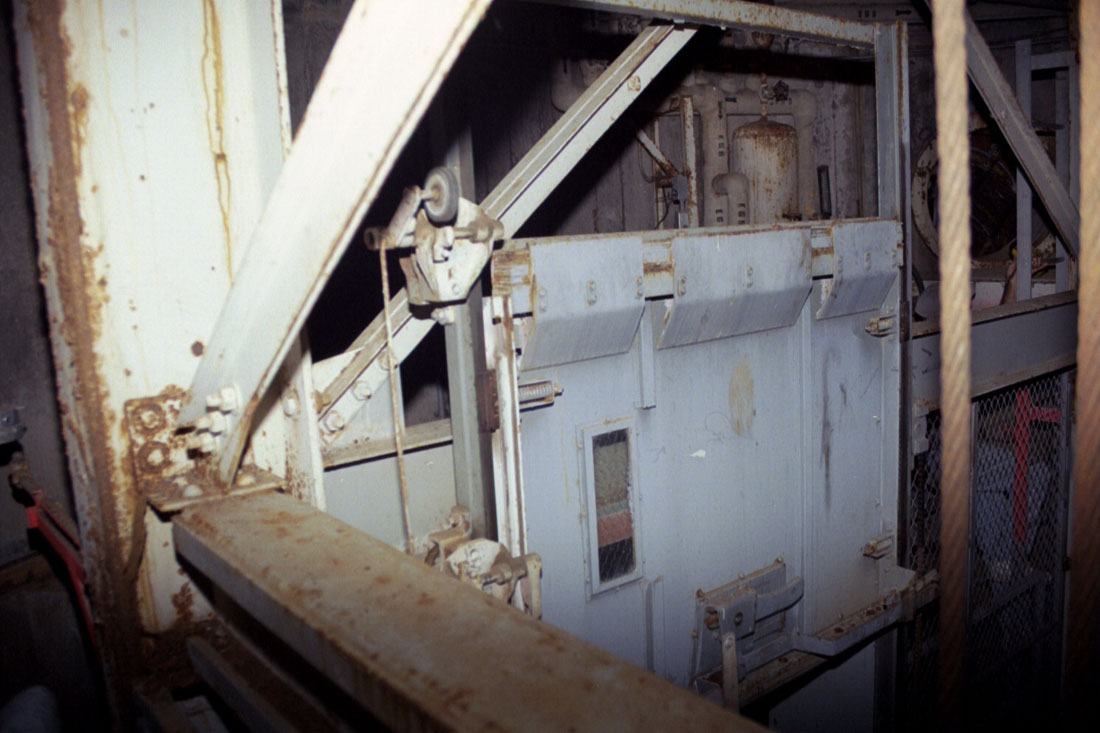
Lowry
724-C, 1999: First look into the portal silo. Here you see the
elevator shaft-- the car is at the bottom but the doors are visible with
a small window. The walkway and stairs lead around the elevator
shaft. Just over this beam at the bottom center is a 60-foot drop
to the bottom of the silo.
If
you look very closely, you can see a small tunnel in the background at
the upper right between the elevator cables: That is the access
tunnel to the TV camera tube. The tunnel is very narrow and
usually has muddy water in the bottom. I never crawled in there
but someone else did and said the camera assembly is still in there--
probably minus the camera however.
|
|
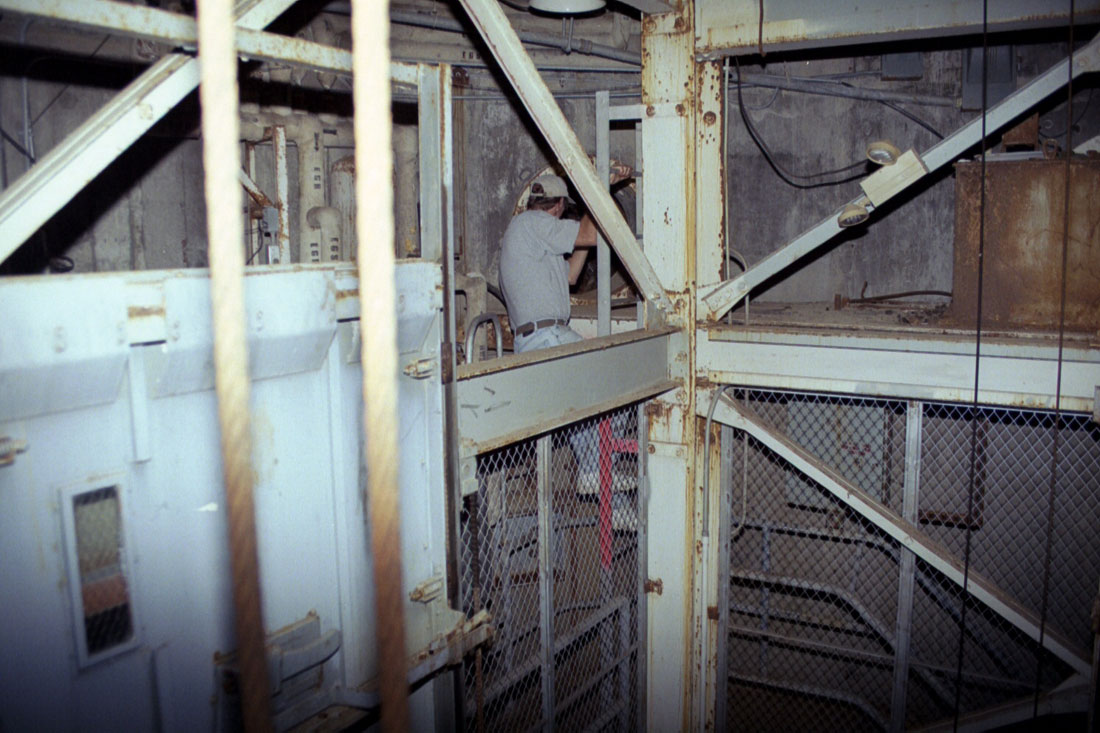
724-C,
1999: Looking across the portal silo, the elevator doors at left, you
can see Mr. X climbing a short ladder to a service platform that offered
access to the TV camera tube and also to hydraulic equipment for the
silo doors.
|
|

724-C,
1999: Looking across the portal silo at the maintenance platform.
Note the newer emergency lighting installed by post-site closure
contractors. Needless to say, it doesn't work anymore.
|
|
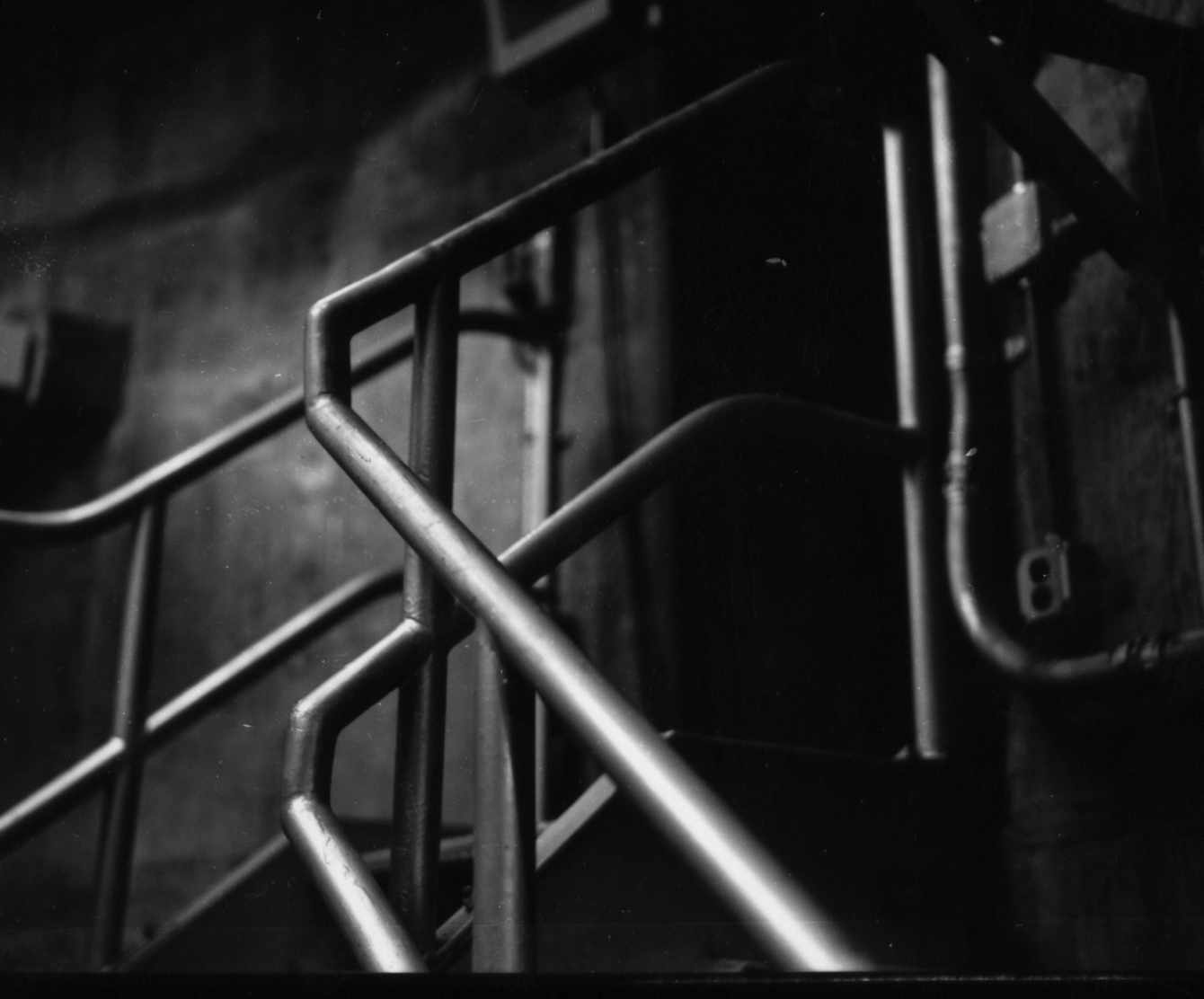
Historical
photo at unknown Lowry Titan 1 site: Looking up a small flight of stairs in the
portal silo leading to the revolving blast door.
Photo
courtesy of Fred Epler
|
|
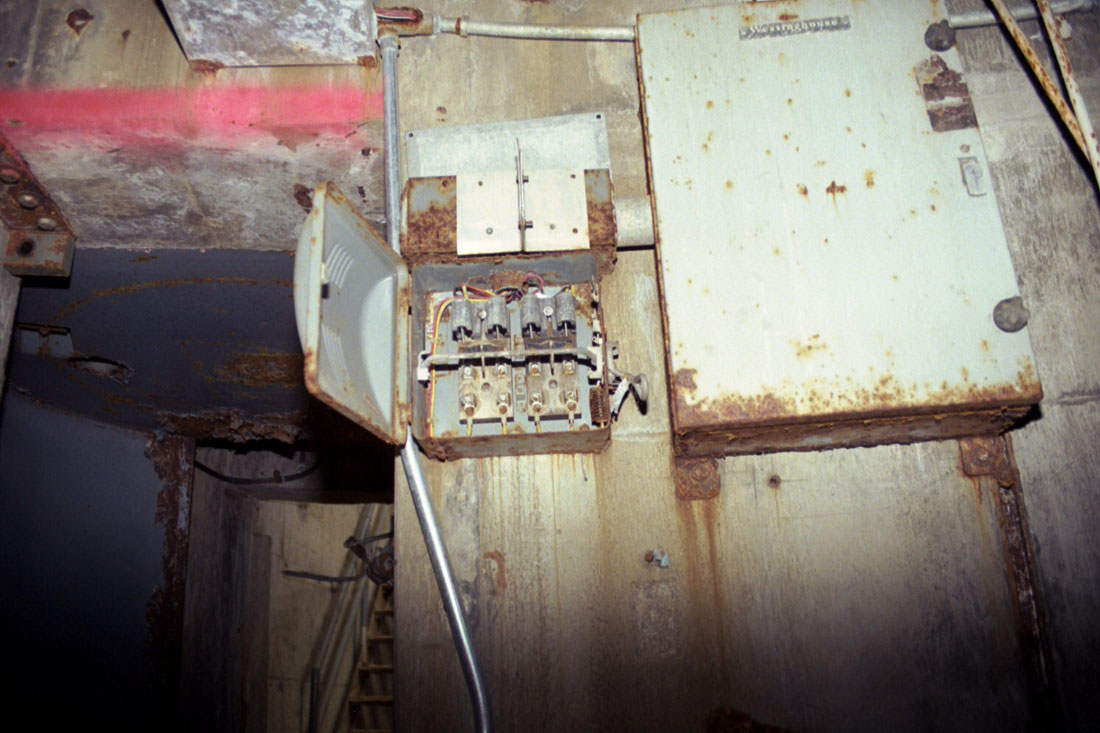
724-C,
1999: Looking out from inside the entry portal. You can see into
the area once occupied by the revolving blast door where there is gray
paint, and beyond that the cellar stairs can be seen leading up to the
surface.
|
At
this point you've hardly even entered the site. The next photo
gives you feel for the depth, but a picture really doesn't convey the
feel of the place adequately.
|

Lowry
725-B, 1978: photo looking
upward from inside the freight elevator shaft. The elevator can
rise through the open silo doors to the surface for loading and
unloading. Note the ladder in the shaft provided for escape if the
elevator should become stuck.
Photo
courtesy of Fred Epler
|
|
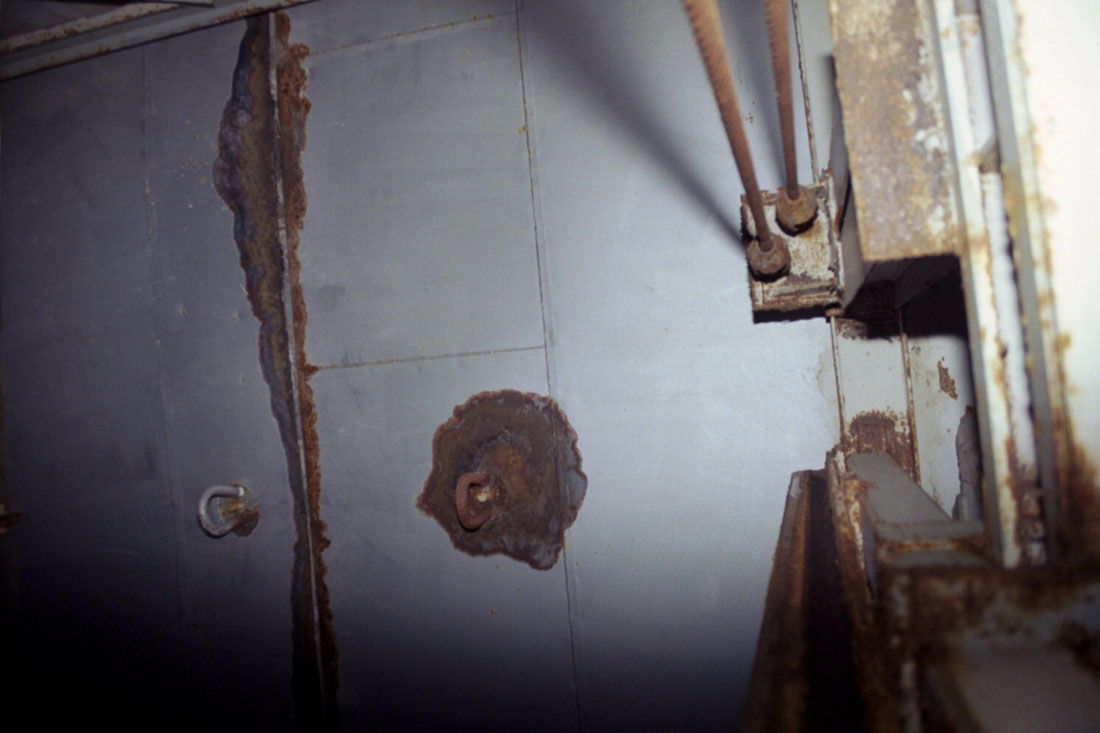
Lowry
724-C,
1999: Same view as the previous photo only taken decades later and
zoomed in closer. The steel lining on the inside of the silo doors have fared
rather well after such a long time.
|
|

724-C,
1999: Heading around the first corner you can see two of the supports
for the hydraulic door rams that protrude from the silo wall. The
rams have been removed, but someone (perhaps salvage contractors) has
mounted a small hand winch on the support.
A
rat's nest of plumbing can be seen in the background as well and one of
the stealthy silo gnomes that inhabit the site lurks in the shadows on
the maintenance platform.
|
|
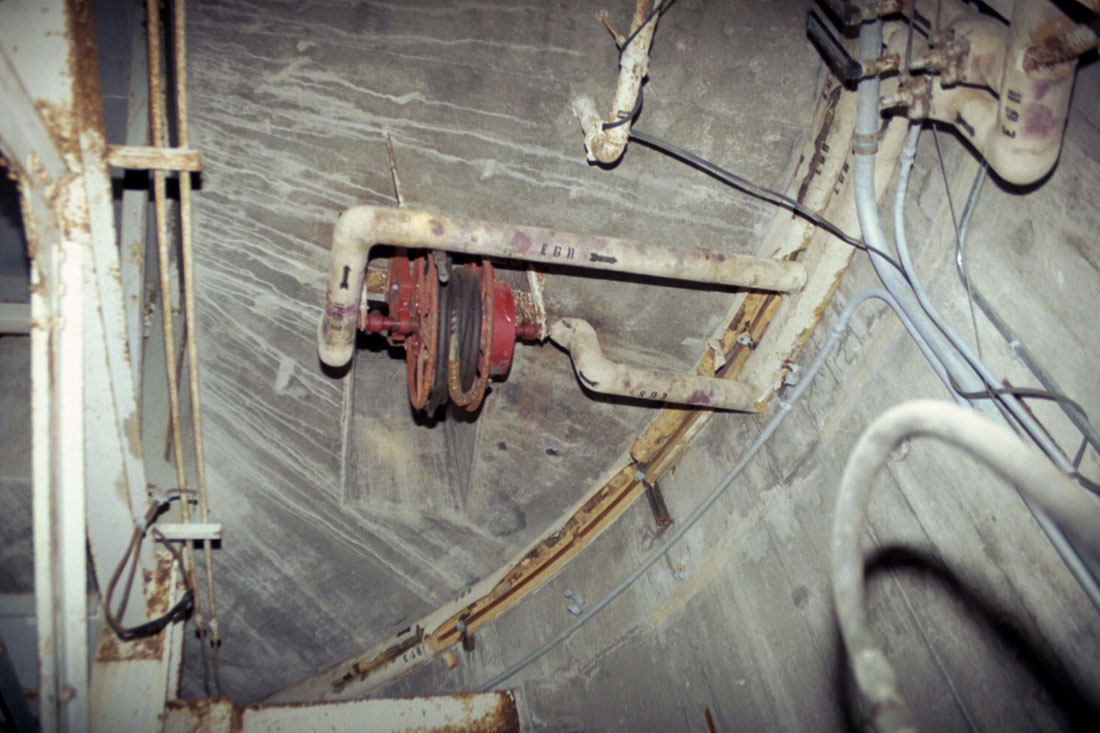
724-C,
1999: Looking upwards at the silo cap. The red reel is the hose
take-up assembly for one leaf of the silo doors. The hose
circulated heated ethylene glycol through the doors and silo cap to melt
snow and prevent frost and ice from freezing the doors shut in cold
weather. The reel allowed the doors to open and close with the
glycol line moving with the doors.
|
|
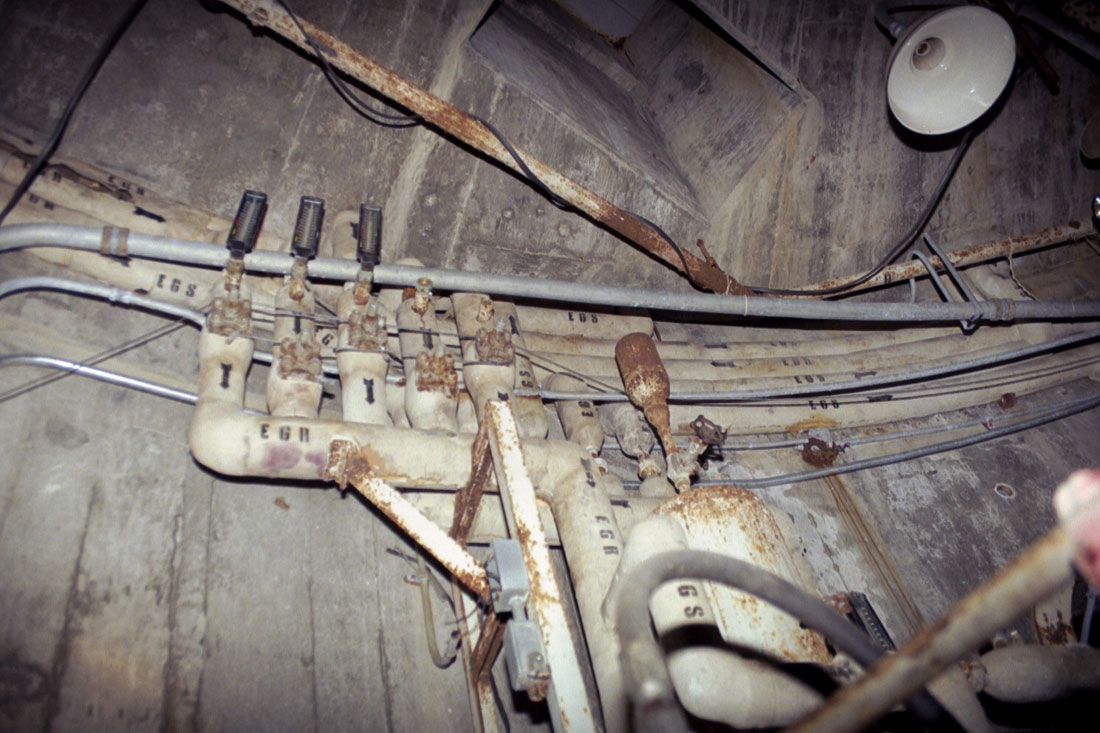
724-C,
1999: Looking upward at the ethylene glycol plumbing. The opening
in the concrete is where the hydraulic door ram passed through to
connect to the door which overlapped part of the silo cap for strength.
|
There's
a lot to see in just this relatively small area. Given plenty of time,
it's quite easy to forget how long you've been down in a place like
this. Many times I entered the complex when it was daylight-- early
afternoon even, and was stunned later when I emerged into the cold dark outside.
I
frequently lost all sense of time while down there, and with no references at all,
become chronologically disoriented. It was not unusual to think I'd
been underground for two or three hours only to discover that six or
seven
hours had passed!
|
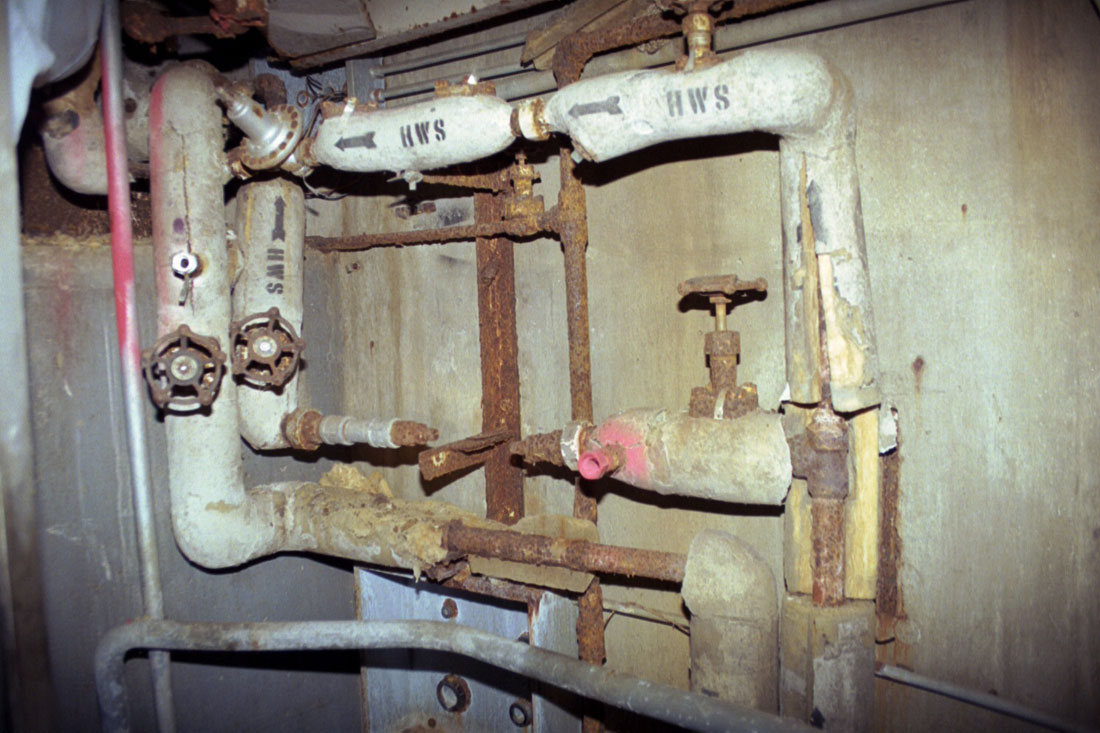
724-C,
1999: More plumbing at the upper level of the entry portal. Most
of the asbestos in the site was in the form of thermal pipe and conduit
insulation. However, the bulk of what you see here is actually
fiberglass insulation. The straight sections of pipe were
typically covered with fiberglass while elbows and 'T's were usually
covered with asbestos plaster. This holds true throughout the
entire complex mostly except for the generator exhaust pipes which were
insulated entirely in asbestos because of the high temperatures
involved.
|
Other
times I would return to the surface to find a storm rolling in or to find it
actively raining or even snowing when I had gone in under clear skies.
It felt very odd to find the weather completely changed on exiting the site.
|
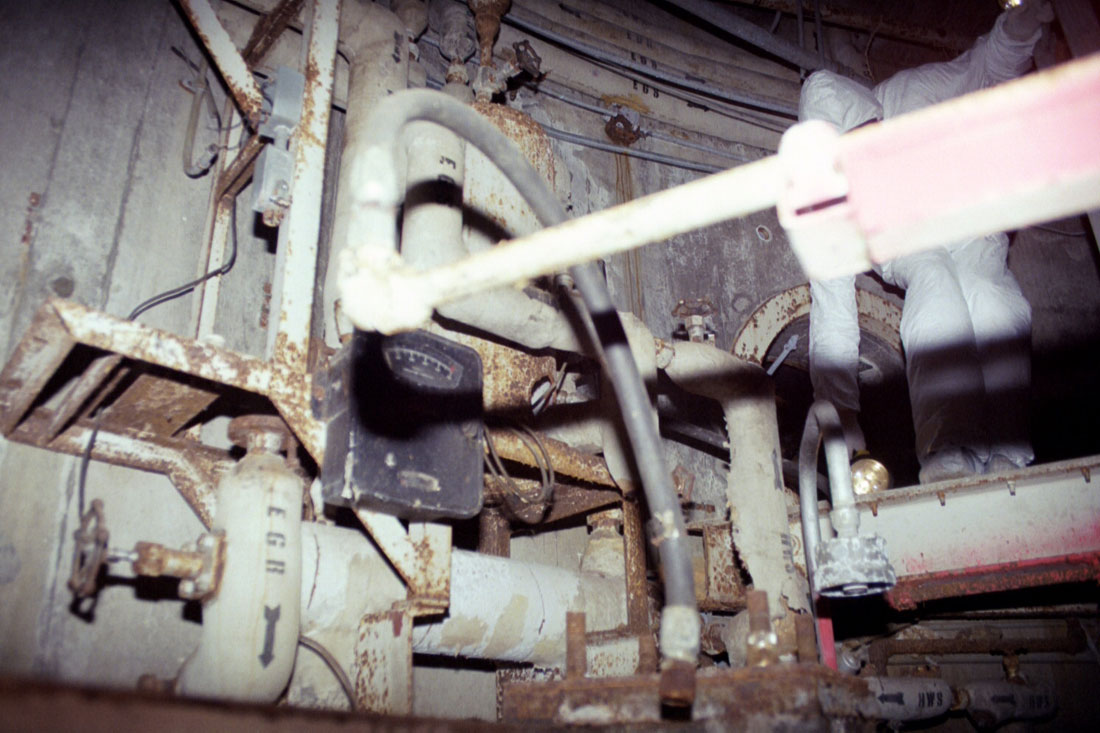
724-C,
1999: More plumbing and another silo gnome on the maintenance
platform. Once again, you can see the access to the TV camera tube
in the background.
|
|

724-C,
2002: Looking down the elevator shaft through the elevator doors.
The stairs can easily be seen leading down around the shaft. This
was taken with a much better camera and flash than mine as you can see.
Photo
courtesy of S. Malloy
|
|

724-C,
1999: Slightly different shot of the elevator shaft showing details of
the stairs and support structure.
Photo
courtesy of S. Malloy
|
|
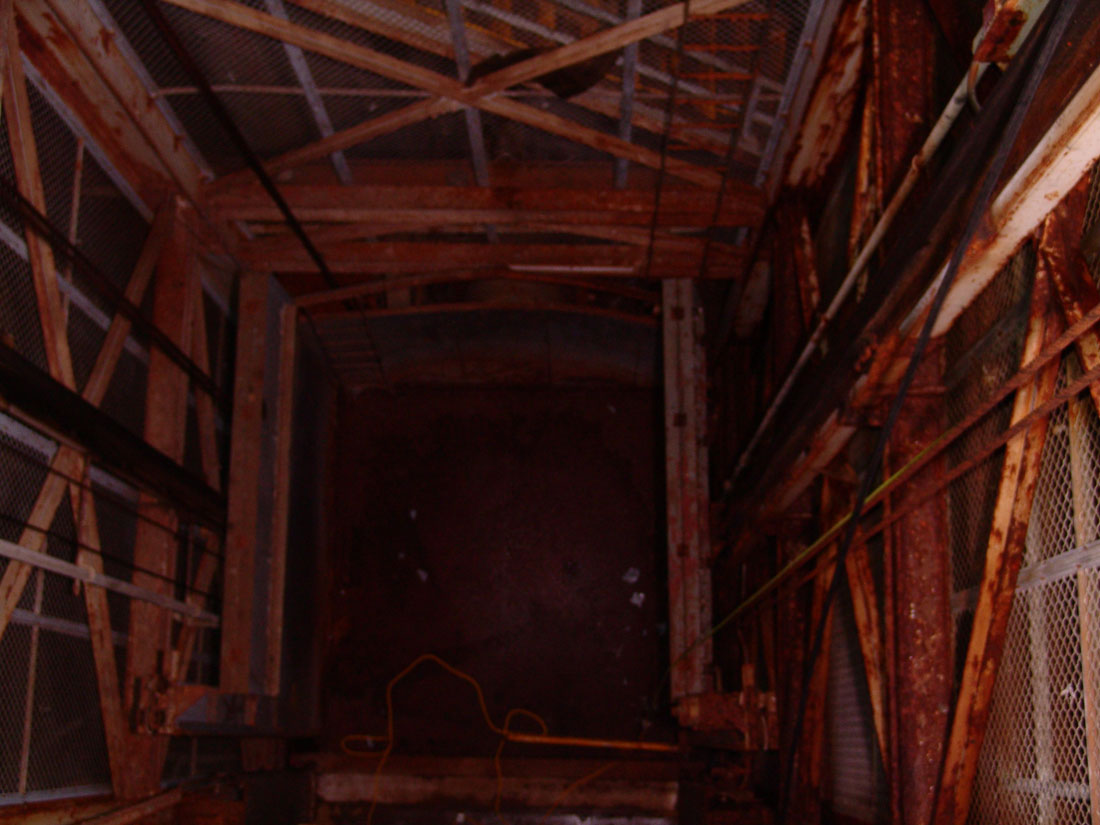
724-C,
2002: Looking down at the bottom of the elevator shaft where the car
sets rusting.
Photo
courtesy of S. Malloy
|
|

724-C,
1999: Up on the maintenance platform the hydraulic reservoir for the
entry portal silo doors sets and rusts. The motors and other
equipment are long gone, but this box of hydraulic fluid
remains.
|
Daring
Doo
Up
on the beams around the top of the silo was where we discovered one of
the oddest things at 724-C. Carefully balanced atop the steelwork
were random piles of feces-- not human fortunately, for that would just
be disturbing given the precarious and downright dangerous location--
but animal feces. They were not small animals like rodents that could easily
fit on a narrow I-beam, no, they appeared to be from coyotes or some
other canine and were planted hither and yon atop the beams of the
structural steel.
This
enigmatic excrement puzzled us deeply; there appeared to be no way
anything larger than a mouse could squeeze inside the portal silo,
perhaps through the gaps in the concrete near the original hatch.
Even more perplexing was how all this scattered scat came to be on such
a narrow beam requiring an acrobatic animal to jump up about 5 or 6 feet
without toppling over the other side and then carefully balance on a
space 8 inches wide in order to perform the deed.
A
theory (unproven but plausible I think) formed whereby the hatch must
have been left open for some time by the company occupying the site,
giving curious coyotes a chance to find the entrance and seek shelter
inside. During their visit, they somehow performed their odious
"haute fécole" and were later shooed away when the
caretakers returned and closed up the hatch, perhaps completely unaware
of the crime(s) perpetrated by the deft defecators which lay steaming
overhead.
And
so, many years later, the desiccated dung remains, hidden from view
above eye level, it's very presence begging the question of future
generations: How the hell did that get there?
|
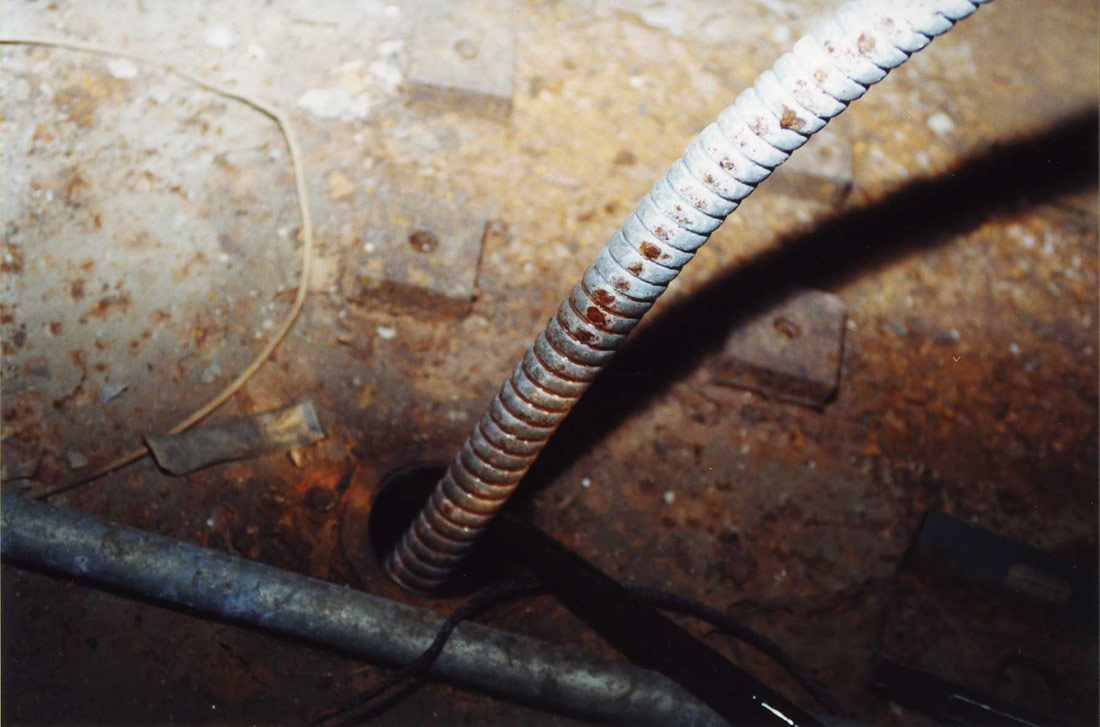
724-C,
1999: Plumbing the hydraulic accumulator to see if there is still fluid
in there.
|
|
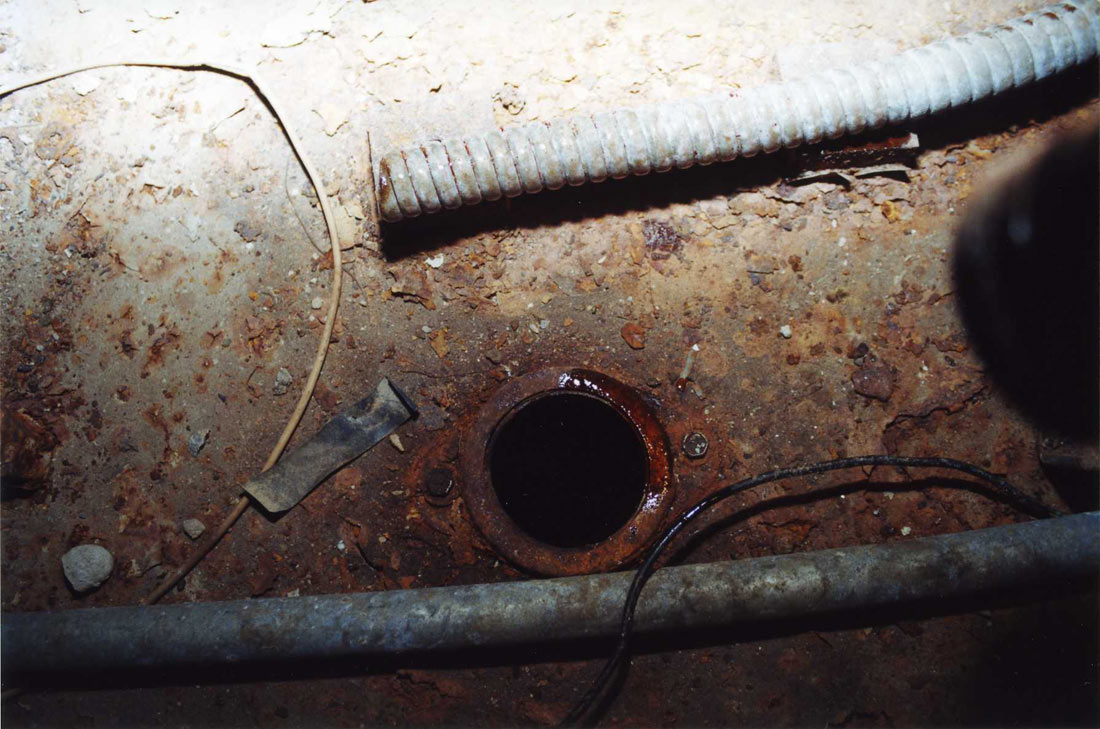
724-C,
1999: Yes there is still fluid in there!
|
|
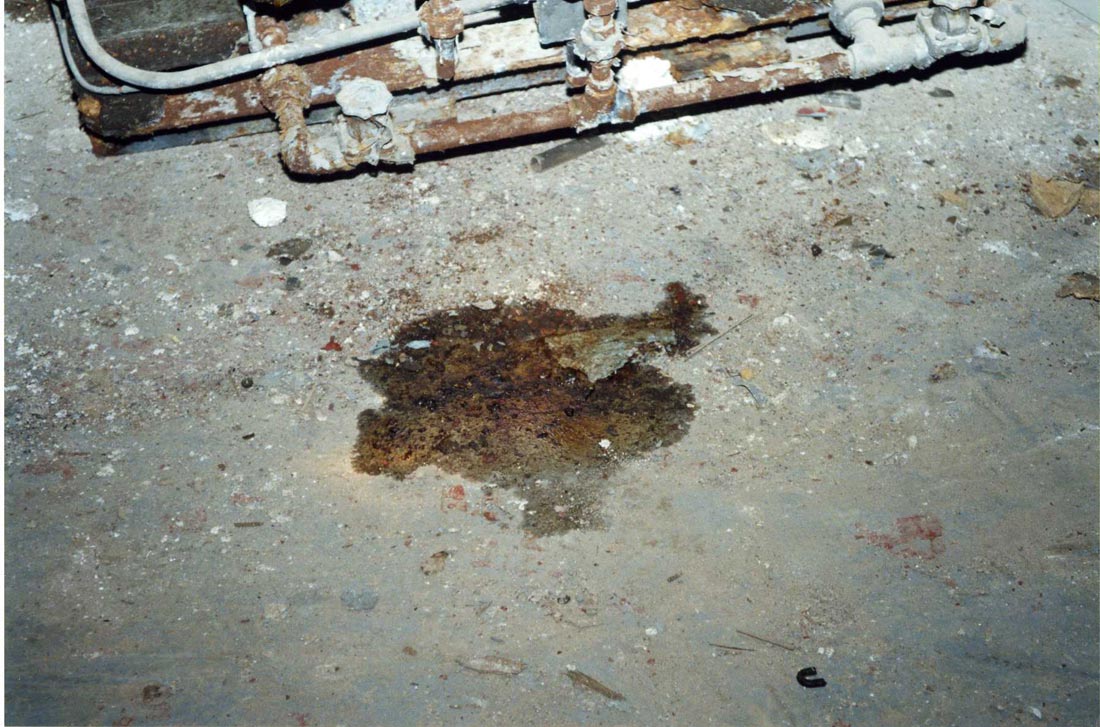
724-C,
1999: Any agencies interested in the environmental cleanup of the site
would do well to take note of the many gallons of hydraulic fluid still
sitting in this tank in the entry portal silo.
|
|

724-C,
1999: Portal silo door controls and logic panel. I'd hazard a
guess and say it's out of order.
|
All
this and you're still really not even started descending into the
site. Enough delay, time to really begin heading into the facility
proper.
|
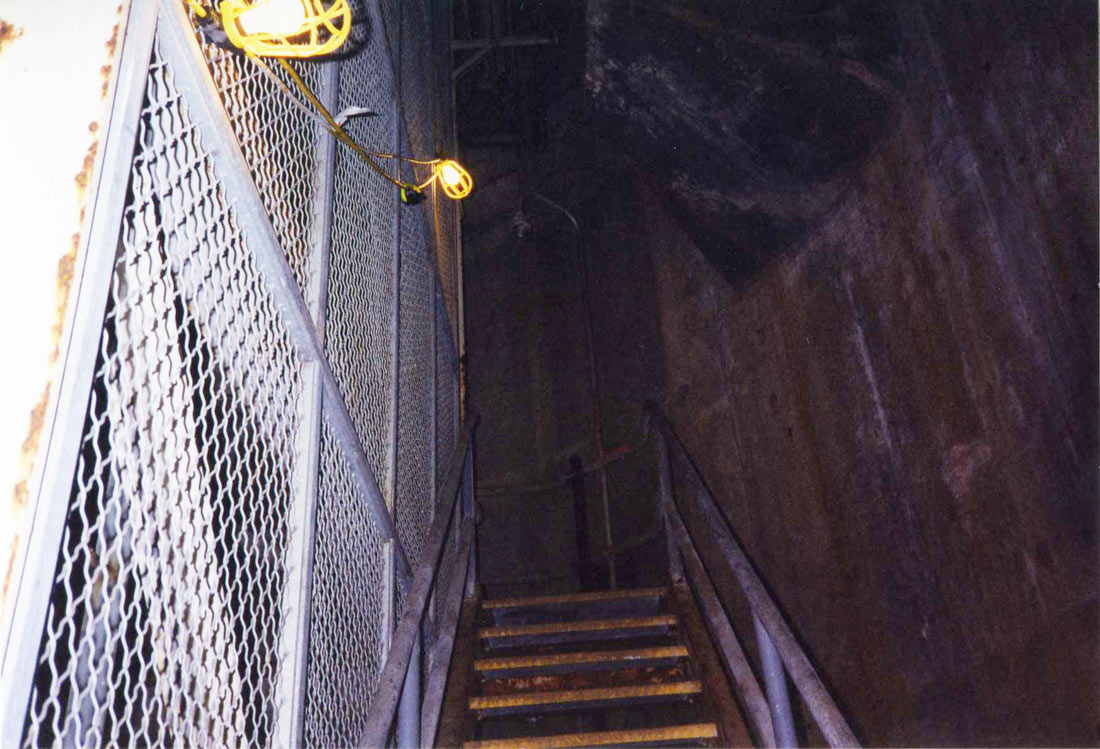
724-C,
1999: Looking back up the first set up steps descending down the long
route to the bottom. The work lighting was installed by myself and
an associate. When I returned in 2005 to assist the Army Corps. of
Engineers, I had to replace about one third of the bulbs which had
corroded badly in the very wet environment.
|
|
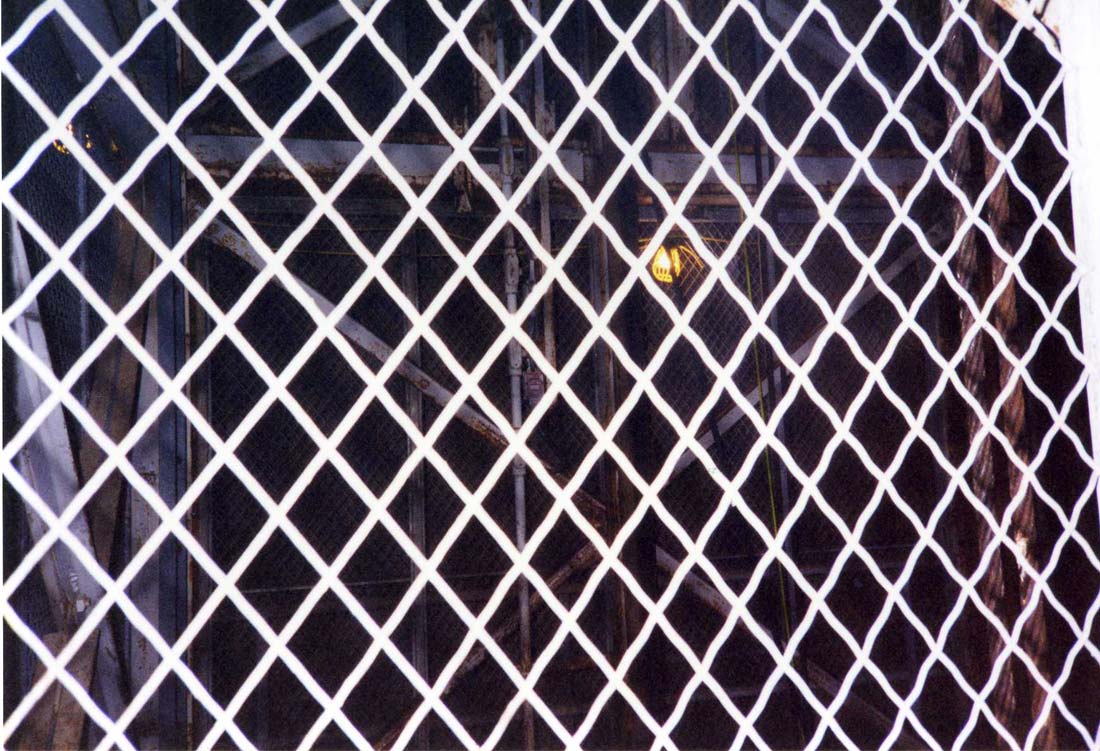
724-C,
1999: Looking through the heavy steel mesh around the elevator shaft
|
|

724-C,
1999: Looking down the portal silo over the stairs railing. The
light far below is the reflection of the camera flash.
|
Now
the temperature starts to drop quite noticeably. If you didn't
dress warmly, you could well regret it: chances are that the temperature
inside the Titan 1 site will be around 55F or less year
round. Not so bad in Winter, but in July it can be a bit of a
surprise if you don't plan ahead.
|

Larson
568-A: A nice brightly-lit shot of the entry portal stairs and attendant graffiti.
Photo
courtesy of Walter Silva
|
Water
regularly leaks into 724-C from gaps in the seals on the giant silo
doors and from conduits left open after their wiring was
salvaged. Some water runs down the walls while other small flows drip
from the overhang at the silo cap. Trickles run down the portal
silo sump discharge pipe from gaps in the concrete and spatter on the
stairs, railings and platforms.
The
wet stairs are certainly something to be careful about but surprisingly,
they are not as treacherous as you'd imagine and do have a non-skid
hatch pattern on them. At the same time, the stairs are narrow,
somewhat steep and dark so one feels inclined to caution if they don't
fancy a terrible spill.
Puddles
sit on the walkways and spill over into the silo which fills up and in
turn spills over into the adjoining tunnel junction, T.J.#10. All
the tunnels meeting at the main junction are sloped down towards the
power house. All the water flows under the floor and into the pipe
trench in the power house.
|
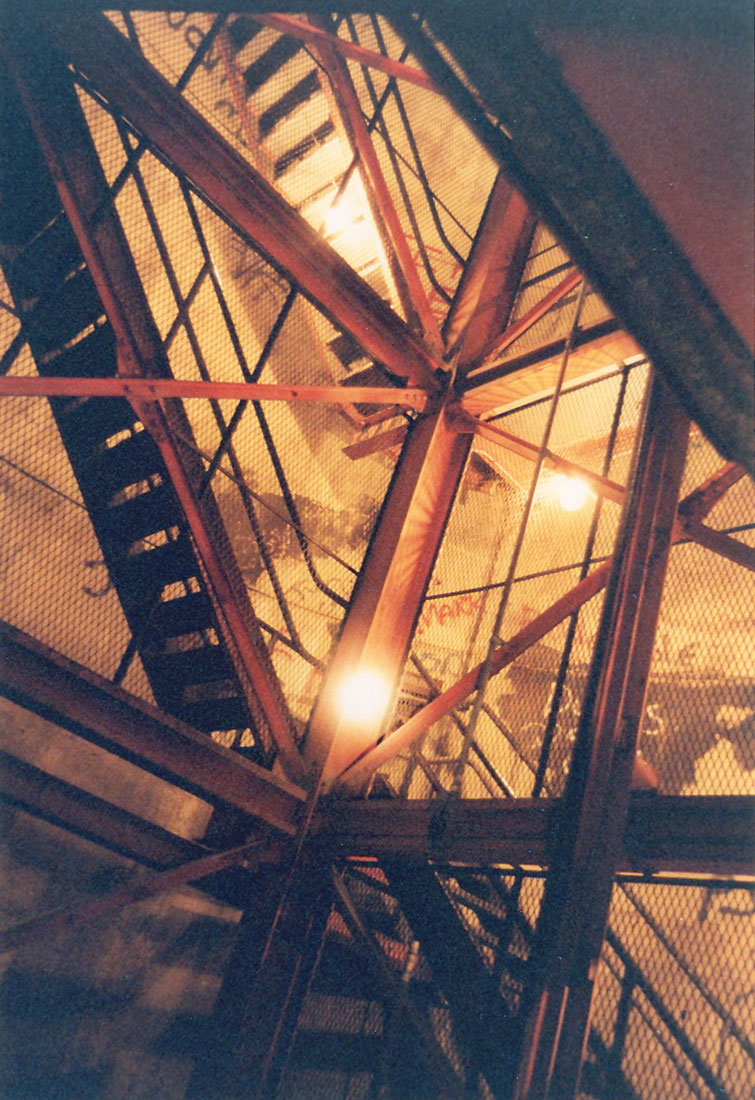
Larson
568-A: A very nice view of the elevator shaft and portal stairs.
In spite of all the spray paint and being open, this site looks to be in
pretty decent shape and much drier than many sites.
Photo
courtesy of Walter Silva
|
This
drainage arrangement was intentional I'm sure because the power house
had a robust dual sump pump setup over near the office. If a pump
in the control center or portal failed or couldn't keep up, the water
would make it's way down to the power house and be purged from the pipe
trench sumps.
Of
course the pumps are no longer operating so this would ordinarily have
left the entire area flooded periodically or permanently as it has been
at other sites. With all the water that gets in, 724-C should be
fairly swamped by now, but it isn't.
Here's
why:
There
are two deep wells in the power house that once supplied all the water
for the site. When the site was closed and later scrapped out, the
piping to the wells was removed leaving the top of the wells open.
The well heads are at the bottom of the pipe trench and when the level
in the trench gets high enough, the water spills over into the wells and
down about 1800 feet into the Colorado aquifers.
Basically,
the wells in the power house have acted as a giant drain for 724-C for
decades. Were it not for the open wells, large portions of the
site might be completely submerged. Of course this means that a
lot of unsavory-looking water is making it's way into the water
table. Where it ends up, I have no idea, but as of 2005, the wells
were still open and still swallowing filthy water from 724-C.
|

724-C,
1999: Perhaps half way down
|
|

724-C,
1999: Almost at the bottom. The last set up steps is right around
the corner.
|
I
had no idea how far down this silo went that first time years ago.
Looking over the edge, I could see water reflecting my light below but
could not estimate how far away that water was. The stairs seemed
interminable as I went down, down, down.
Finally,
I could see something below in the gloom. What could be down
there?
---------------------------
In
the next section you can see what I found far below the surface at the
bottom of the portal silo. Click the link below to continue to the
next section or you can go to the Main
Map to explore elsewhere.
Entry
Portal section V or Go
to Main Map

| Contact |
Site Map | Links
|
Hosted by
InfoBunker








